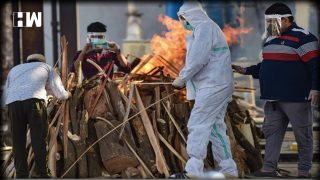Udaipur: India records it’s first Omicron Death on Wednesday January 4. Samples of a man in Rajasthan’s Udaipur, who died last week, possessed the presence of the variant.
Confirming the news, Joint Secretary of Health Ministry, Luv Aggrawal said: “Technically it is Omicron related death (on the Rajasthan case). He was an elderly person. The person is reported to have comorbidities, like diabetes among others.”
As per the PTI reports, the reports of the elderly man had came negative twice. He died due to post-Covid pneumonia coupled with comorbidities—diabetes mellitus, hypertension and hypothyroidism — Udaipur Chief Medical Health Officer (CMHO) Dr Dinesh Kharadi had said.
On December 15 the man had tested positive for covid and was hospitalised with symptoms like fever, cough and rhinitis.
The genome sequencing result received on December 25 revealed that the man was infected with the Omicron variant.
Addressing a press conference here, Indian Council of Medical Research (ICMR) Director General Dr Balram Bhargava said the spike in the number of Covid cases is being witnessed in cities and “the Omicron variant is the predominant circulating strain”.
Mass gatherings need to be avoided to lower the speed of the infection spread, he stressed. “We are now facing an exponential rise in (the number of) COVID-19 cases and we believe that largely, it is being driven by Omicron, particularly so in the western parts of our country and even particularly so in larger cities from where we have more data,” NITI Aayog member (Health) Dr V K Paul said.
On December 30, the case positivity rate was 1.1 per cent and the next day, it was 1.3 per cent and now, the country is reporting a positivity rate of five per cent, he said, adding that similarly, there were 13,000 Covid cases on December 30 and the number went up to 58,000 on Tuesday.
“Clearly, this is an expanding pandemic. The R nought value is 2.69. This is higher than the 1.69 we saw when the second wave of the pandemic was at its peak. The acceleration of cases is steeper than ever,” Paul said.
He, however, added that the hospitalisation rates are relatively low. It is close to 3.7 per cent in Delhi and five per cent in Mumbai. “That is the early input we have. Compared to this, last year and even in 2020, the hospitalisation rate was close to 20 per cent,” Paul said.
As an independent media platform, we do not take advertisements from governments and corporate houses. It is you, our readers, who have supported us on our journey to do honest and unbiased journalism. Please contribute, so that we can continue to do the same in future.

